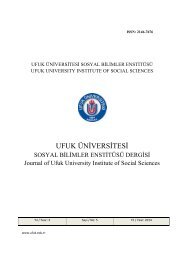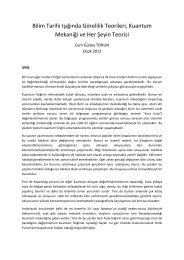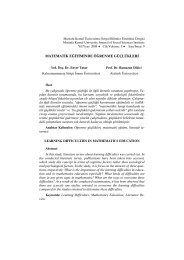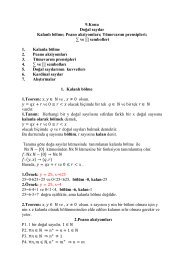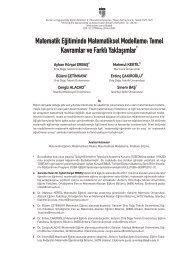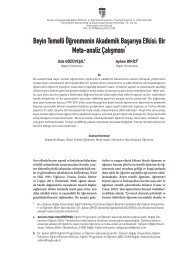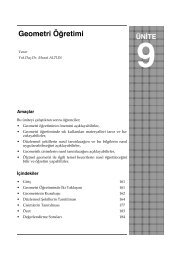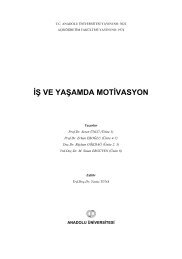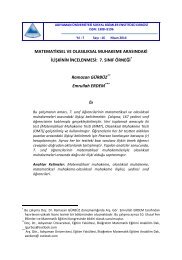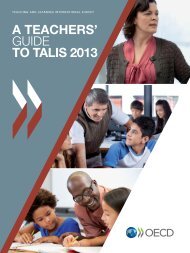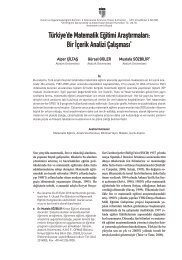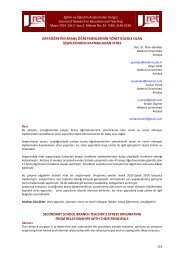bd798f7e557c386e7e231ced888acec57061
bd798f7e557c386e7e231ced888acec57061
bd798f7e557c386e7e231ced888acec57061
- No tags were found...
Create successful ePaper yourself
Turn your PDF publications into a flip-book with our unique Google optimized e-Paper software.
EDUCATIONAL SCIENCES: THEORY & PRACTICE<br />
Turkish colleagues. Yet, it was also reported that<br />
German teachers paid more attention to gender<br />
difference while forming groups and used their authority<br />
more compared to their Turkish colleagues.<br />
When the interviews and field notes are considered<br />
together, it can be claimed that these two attitudes<br />
of German teachers were not in contradiction with<br />
each other and the value productivity lies behind<br />
their attitudes.<br />
Another important finding of the study demonstrates<br />
that gender differences have an effect on<br />
teachers’ decision-making processes. The value<br />
gender differences can be considered in Lim and<br />
Ernest’s (1997) category of “social and cultural<br />
values” and Bishop’s (1988) category of values at<br />
“societal level”. This value can be regarded as the<br />
most striking value that explicitly shows the social<br />
and cultural differences between the two countries.<br />
In the study, it was found that German mathematics<br />
teachers paid more attention to this value while<br />
making decisions than their Turkish colleagues.<br />
They also identified the sub-values esthetics, beauty,<br />
and neatness (especially for female students)<br />
and gender-based collaboration in the category<br />
of gender differences. Here, it can be argued that<br />
these values correspond to the values attributed<br />
to the women in Western culture. In the theory of<br />
gender-based values suggested by Gilligan (1982),<br />
the values attributed to the women in Western culture<br />
are connections, caring, empathy, feelings and<br />
intuition, tends to holistic and human-centered<br />
whereas the values attributed to the men are unfeelingness,<br />
objectification, abstraction, impersonality,<br />
dispassionate reason and analysis, and tends<br />
to be atomistic. Thus, it is understandable that German<br />
teachers identified the values esthetics, beauty,<br />
and neatness as the values attributed to the women.<br />
The mathematics programs affected by the values<br />
at “institutional level” as Bishop (1998) indicated<br />
also support this identification. To illustrate, the<br />
German secondary mathematics program (Rahmenlehrplan<br />
für die Gymnasiale Oberstufe [RGO],<br />
2006) emphasizes this as follows:<br />
In lessons, learning environments in which students<br />
with different gender work together promote<br />
students’ understanding and awareness of<br />
self and the opposite gender’ learning. They support<br />
the phenomenon of living with the opposite<br />
gender in life. They also encourage students to<br />
make independent decisions for their personal<br />
and professional lives from the socially and traditionally<br />
attributed roles (p. 7).<br />
On the other hand, when Turkish teachers were<br />
asked whether they considered gender differences<br />
while forming groups, it was observed that all (except<br />
for T3) gave priority to the value “productivity”<br />
and they did not voice any opinions related to gender<br />
differences. However, it is obvious in the following<br />
statements that MEB (2009b) attach great importance<br />
to the gender distribution across groups:<br />
“Teachers should form heterogeneous groups in<br />
terms of students’ gender, academic achievement,<br />
etc. in group projects” (p.107) and “ In collaborative<br />
learning, teachers should form homogenous and<br />
heterogeneous groups by taking students’ achievement<br />
levels, genders, personality characteristics<br />
into account” (p. 25). The reasons lie behind the<br />
importance Turkish teachers attach to the value<br />
productivity are explicable. In Turkey, the Turkish<br />
education system is based on large scale centralized<br />
exams (Yıldırım, 2008) and the success or failure<br />
of Turkish teachers is determined by the means of<br />
these exam results at both institutional and societal<br />
levels. With this, it can be concluded that societal<br />
and institutional values are effective on Turkish<br />
mathematics teachers’ classroom practices (group<br />
formation) (Bishop, 1988; Lim & Ernest, 1997).<br />
Similarities and Differences in the Category of<br />
Values in Mathematics Education<br />
When the underlying values of the mathematics<br />
teachers’ decision-making processes during classroom<br />
practices are examined in the framework<br />
of Hofstede’s Category of Cultural Values (1980),<br />
interesting and striking findings appear to stand<br />
out. In Hofstede’s (1980) study, it was concluded<br />
that the Turkish society has a high power distance<br />
index and high levels of uncertainty avoidance index.<br />
It was also found that the Turkish society has<br />
a collectivist view and it is shaped by the femalespecific<br />
values. Accordingly, as Cooper et al. (2007)<br />
stated, the reflections of these values on classroom<br />
practices are expected to lead to teacher-centered<br />
instruction and result in such a perception that<br />
it is disrespectful to question teachers’ presentation/decision.<br />
However, the findings of this study<br />
prove the opposite. For example, it was found that<br />
Turkish mathematics teachers attached great importance<br />
to student-oriented values (see the value<br />
productivity) in their decision making processes<br />
and they respected their students’ demands even if<br />
they contracted with their own decisions (see the<br />
value flexibility), which may be attributed to the<br />
modification of mathematics programs based on<br />
the constructivist approach. Nonetheless, further<br />
studies are needed to reveal whether these values<br />
are observed in Turkish teachers’ classroom prac-<br />
702





